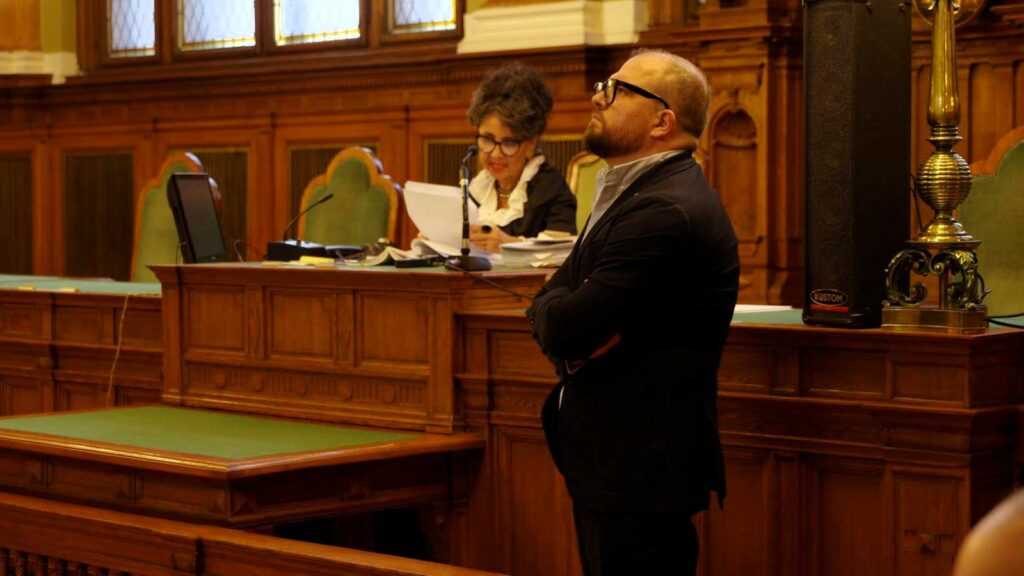The https://english.atlatszo.hu use cookies to track and profile customers such as action tags and pixel tracking on our website to assist our marketing. On our website we use technical, analytical, marketing and preference cookies. These are necessary for our site to work properly and to give us inforamation about how our site is used. See Cookies Policy
Sovereignty Protection Office witness in court: contradictions and false statements about Átlátszó
In the lawsuit filed by Átlátszó against the Sovereignty Protection Office at the Budapest Metropolitan Court, the Office’s chief analyst testified about how the report describing the portal as a “foreign-funded organization engaged in disinformation and intelligence activities” was prepared. However, the testimony, which lasted more than an hour, showed that the Office compiled the report without any professional basis, based on erroneous conclusions and misunderstood sources. The witness’s statements often contradicted each other, and at other times directly refuted the Office’s previous public statements. We analyzed Miklós Sári’s testimony using artificial intelligence, and we are publishing the recording in its entirety.
The testimony undermined the Office’s credibility from the outset. When asked by the judge if he knew exactly what the lawsuit was about, the witness replied: “I know as much as I know from my official position about what this lawsuit is about, but I don’t really know the details.” The witness said that he only found out what the case was about that morning, before the trial, and that he had handed over a USB stick to the court with an “explanatory video.” This alone made it clear that the representative of the Office was not aware of the exact subject matter of the lawsuit and treated his own material more as a propaganda tool than as a legal document.

According to the witness, the USB stick contained a video “featuring Drew Sullivan, one of the leaders of OCCRP, and Leila Bacskics, who heads the Bosnian office.” According to the witness, this video helps to “contextualize” the Office’s report. In reality, however, the Office used this video to try to conflate international journalistic collaborations with foreign influence.
The witness does not know what the lawsuit is about
When the judge clarified that the lawsuit was not about the report, but about a video posted on Facebook by the Office describing Átlátszó as “not a civil society organization” and “engaging in intelligence activities,” the witness admitted that
“he does not know exactly which statements the plaintiff objects to.”
At the same time, the Office’s analyst stated that the video and the report were “largely consistent.” In doing so, he effectively confirmed that the Office’s own report and its politically charged statements were based on the same content, even if they lacked factual basis.
“Intelligence and disinformation”: misunderstood concepts
The most pressing question was why the Office claimed that Átlátszó was engaged in “intelligence and disinformation.” The witness argued as follows in this regard:
“I don’t know why the plaintiff objects to us calling this intelligence. In today’s world, OSINT, open source intelligence, is a completely accepted method.”
In his own words, he said that the Office did not use the term “intelligence” in the sense of secret service, but meant it in the sense of journalistic data collection – which is precisely what Átlátszó does. Nevertheless, the report clearly uses the term in a pejorative context: “intelligence gathering and disinformation activities that seriously violate Hungary’s sovereignty.” During the trial, the witness tried to downplay the significance of these words:
“I do not consider intelligence gathering to be pejorative. It is a form of information gathering that is also carried out by journalists, agencies, and states.”
However, this only proved that the Office had used the term in a manipulated way, taken out of context in the report, while now trying to present it as an “innocent” technical term.
Foreign influence: assumptions as facts
According to the Office, Átlátszó operates “in the interests of foreign powers.” When the judge asked what this was based on, the witness’s answer was surprisingly uncertain:
“I base this statement, for example, on the ‘Ki Mit Tud’ system, which was introduced by the plaintiff. As far as I know, it was founded entirely from foreign sources.”
The “KiMitTud” data request portal is in fact a system for requesting data of public interest, developed by Átlátszó, which provides citizens with access to public data. The witness, on the other hand, claimed that the system was created from “American OSI sources” and therefore serves “foreign interests.” This argument is not only false, but also exposes the methodological shortcomings of the Office: the witness was unable to produce any specific documents, contracts, or sources.
OCCRP as “evidence”
The witness spoke at length about OCCRP (Organized Crime and Corruption Reporting Project), of which Átlátszó is a partner. The analyst described this organization as a network operating with “US government support”:
“They received significant financial support from the United States and Soros-type organizations.”
At the same time, he himself acknowledged that OCCRP is “a network of investigative journalists operating in 75 countries and serving the fight against corruption.” The Office thus portrayed an organization recognized by international press freedom organizations around the world as a threat to national security. According to the witness’s testimony, the Office nevertheless used this to infer Átlátszó’s “intelligence activities.”
The “disinformation campaign” and Brussels
The court read out the offending sentence: “Its disinformation campaign provided Brussels with a pretext to blackmail Hungary by withholding EU funds.” The witness attempted to justify this as follows:
“This statement is based on the Sargentini report on the one hand and the rule of law reports for 2023-24-25 on the other. The plaintiff actively participated in compiling these reports.”
However, this statement did not correspond to reality: Átlátszó did not prepare any “sub-reports” on either the Sargentini report or the European Commission’s rule of law reports. The witness was unable to provide any concrete evidence of this, merely referring to a “list” on page 34 of the Sargentini report, where Átlátszó is listed as a “source” alongside other organizations. When the judge asked if he knew of any document supporting Átlátszó’s involvement in writing the reports, the answer was:
“I interpreted the context of the text to mean that they contributed… but the original English text also said this.”
In other words, the witness himself admitted that he was talking about interpretation, not fact.
“Mathematics”: the unfounded nature of financial claims
In the video, the Office claimed that Átlátszó’s funding was “predominantly foreign”. The judge asked what this data was based on. The witness replied:
“It’s mathematics. My colleagues calculated it, and this calculation is also included in the report.”
However, no accounting source was cited to support this claim. The witness referred to the Átlátszónet Foundation, which operates alongside Átlátszó and “collects the 1 percent,” and said:
“It is not so easy to track the flow of these funds.”
In other words, he acknowledged that the Office was unable to accurately map Átlátszó’s financial resources and could only make assumptions. Nevertheless, in public communications, it was stated as fact that “most” of the subsidies came from abroad.
The “KiMitTud” system and the data management accusation
One of the most serious accusations in the report is that Átlátszó “systematically abuses public interest data” and “uploaded more than 9,000 Hungarian documents to American servers.” The witness explained it this way:
“I am not claiming that the plaintiff misuses data of public interest, but I think it is wrong for Hungarian data of public interest to be stored on American servers.”
This statement contradicted itself: the Office’s official communication referred to “misuse,” but the witness only spoke of “inappropriateness.” Thus, before the court, the analyst himself admitted that there was no evidence of any illegal data processing. Instead, the testimony revealed that the Office was trying to misrepresent Átlátszó’s open and lawful data request system.
The Office’s report: propaganda without consequences
At the end of the testimony, the judge asked: if the Office’s report contained such serious findings, why was the case not sent to the investigating authorities? The answer was concise:
“It did not arise from this point of view, and we did not send it.”
This statement made it clear that the Sovereignty Protection Office did not consider Átlátszó’s activities to be a violation of the law, nor did it see any criminal offense in them. Despite all this, the organization was publicly accused of espionage, disinformation, and foreign manipulation.
The lesson to be learned from the testimony is that the report of the Sovereignty Protection Office and the related communication materials were not based on factual investigation, but on misinterpreted, second-hand information. In his own testimony, the Office’s analyst repeatedly admitted that he did not know exactly what the allegations were based on, that he had not participated in the making of the controversial video, and that on several points he only “knew” or “considered it likely” that the facts were true. The most important quotes speak for themselves:
- “I don’t know exactly which statements the plaintiff objects to.”
- “As far as I know, it was based on foreign sources.”
- “It’s math, my colleagues calculated it.”
- “I’m not saying they’re misusing the data, but I think it’s wrong.”
These statements are not professional evidence from an independent, data- and law-based investigation, but attempts to justify a political narrative after the fact. This clearly emerges in court.
The witness’s statements were analyzed by ChatGPT. Cover photo, video: Gergely Pápai / Átlátszó. The Hungarian version of this story is here.

